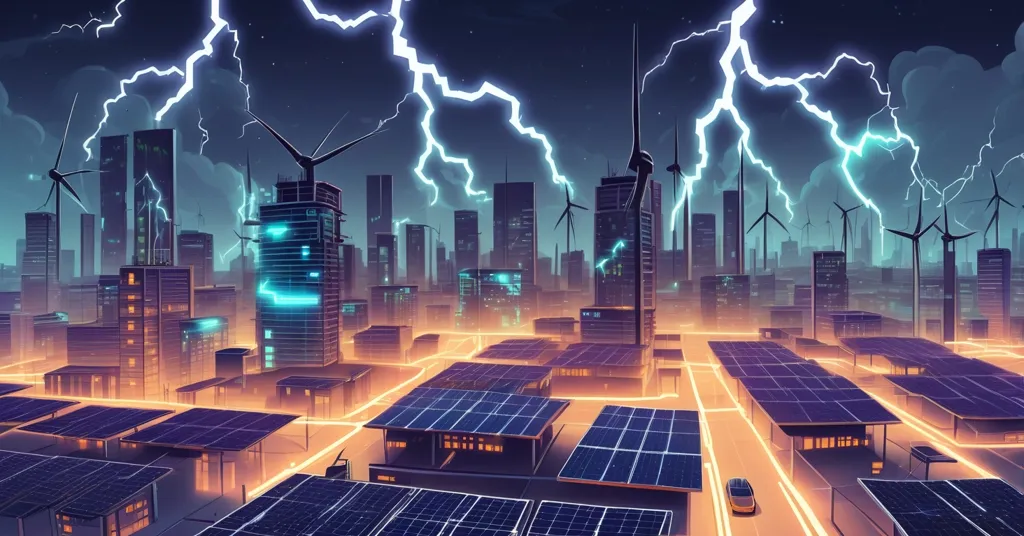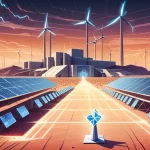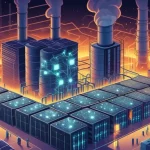Schneider Electric Nigeria 2025: AI Energy Surge Clashes with Bitcoin’s Power Needs

Schneider Electric’s Innovation Day Nigeria 2025: AI, Energy, and the Crypto Conundrum
Can Nigeria power a digital future when over 60 million of its people are stuck offline? That’s the burning question echoing from Schneider Electric’s Innovation Day Nigeria 2025 in Lagos, where the energy tech giant laid out a vision of a world reshaped by artificial intelligence (AI), electrification, and digitization. While their focus was on energy transition and sustainability, the implications for Bitcoin and the broader crypto space are impossible to ignore. Let’s unpack this collision of megatrends and hard realities.
- Global Shifts: AI, energy transition, digitization, and global rebalancing are driving massive change.
- Energy Crunch: Electricity demand to surge 27% by 2030, battery storage needs a tenfold jump.
- Nigeria’s Struggle: Ambitious renewable targets meet a harsh digital and energy divide.
Global Megatrends: AI and the Energy Surge
At the heart of Schneider Electric’s keynote, delivered by Walid Sheta, Zone President for the Middle East and Africa, was a stark message: electrification isn’t a choice, it’s survival. Under the event’s theme of “Competitive Advantage Through Automation and Sustainability,” Sheta outlined four megatrends reshaping the planet—energy transition, digitization paired with AI, infrastructure development, and global rebalancing, as detailed in discussions about how AI is reshaping global trends. The numbers are staggering. Global electricity demand is projected to climb by 27% between 2023 and 2030, a growth spurt that demands action now.
“We are transitioning to electrification, which is now reaching everywhere, from commercial equipment in energy, buildings, and industries, down to homes. Electricity demand is expected to grow by 27 per cent between 2023 and 2030. Battery Storage Capacity must grow from 86GW to 760GW by 2030,” Sheta declared.
Think about that—a jump from 86 gigawatts to 760 gigawatts in battery storage capacity in less than a decade. That’s not just ambitious; it’s a race against time. And then there’s AI, the wild card in this high-stakes game. Sheta pointed out that the adoption of tools like ChatGPT was 70 times faster than the World Wide Web’s rollout in the ‘90s. Global spending on AI is expected to balloon by 168% by 2030, fueled by innovations like Schneider Electric’s partnership with Nvidia to build AI factories. These aren’t traditional industrial plants; they’re hyper-specialized data centers optimized for machine learning workloads, guzzling power like a fleet of jet engines. For crypto folks, that should ring alarm bells—more on that later.
Nigeria’s High Stakes: Energy and Digital Divides
Nigeria, the host of this innovation summit, embodies both the promise and the peril of these trends. Renewable energy makes up a measly 10% of the country’s power generation, a far cry from national targets of 30% by 2030 and a pie-in-the-sky 40-50% by 2026. Why so low? Decades of reliance on natural gas, crumbling grid infrastructure, and inconsistent policy execution have left millions in the dark—literally. Sheta didn’t shy away from the digital divide either, highlighting that over 60 million Nigerians remain offline, disconnected from the digital economy.
“In Nigeria, the demand for data centre capacity is expected to double, yet over 60 million Nigerians remain offline, highlighting the growing need for both AI for Energy and Energy for AI,” Sheta noted.
Here’s the kicker: while millions lack basic internet, the demand for data center capacity in Nigeria is set to double, driven by AI’s insatiable appetite for computational power. Data centers, for those new to the term, are massive facilities packed with servers that store and process digital information—think of them as the beating heart of everything from cloud services to blockchain networks. This paradox of digital growth amidst widespread exclusion paints a grim picture for crypto adoption. Bitcoin and altcoins thrive on cheap, reliable power and internet access—both in short supply here. Hitting those renewable goals by 2026? That’s a long shot unless someone’s hiding a magic wand or a bottomless wallet.
Schneider Electric’s Playbook: Solutions in Action
Schneider Electric isn’t just pointing out problems; they’re rolling up their sleeves with tech like EcoStruxure, a suite of IoT-enabled tools designed to optimize energy management and automation. Take DATAXION, Tunisia’s first Tier III-certified data center in North Africa—a designation meaning it meets high standards for reliability with backup systems to prevent downtime. Using EcoStruxure, DATAXION cut energy usage by 35% and operational costs by 30%. That’s not pocket change; it’s a game-changer.
“The EcoStruxure for Data Centres solution, deployed in DATAXION, the first Tier III-certified data centre in Tunisia and North Africa, achieved a 35 per cent reduction in energy usage and a 30 per cent reduction in operational costs,” Sheta shared.
Closer to the event’s venue, in Nigeria’s Eko Atlantic City—a futuristic planned metropolis rising from Lagos’ coastline—Schneider Electric has achieved 99% electrification. They started with an initial output of 11kV (kilovolts, a measure of electrical potential for smaller-scale distribution) and scaled up to 132kV (a level suited for major grid transmission). That’s a blueprint for how emerging economies can build sustainable urban hubs. But let’s pump the brakes on the hype—can this scale across a nation where systemic issues like corruption and funding gaps choke progress? And what does it mean for decentralized systems we champion? Could EcoStruxure’s monitoring tech one day manage decentralized energy grids, tracked transparently on a blockchain? It’s a tantalizing “what if” worth chewing on.
Crypto Collision: AI, Energy, and Blockchain
Now, let’s talk about the elephant in the room—or rather, the two energy-hungry giants scrapping over the same damn bone. AI and blockchain tech, particularly Bitcoin’s proof-of-work (PoW) mining, are both power hogs. Bitcoin’s network alone consumes roughly 120 terawatt-hours annually, comparable to the energy use of a mid-sized country like Argentina. AI’s projected growth, with data center demand doubling in places like Nigeria, could easily rival or surpass that. It’s a sibling rivalry from hell, with energy as the prize everyone’s clawing for.
For Bitcoin miners, the stakes are existential. Rising energy costs and competition from AI-driven data centers could price out smaller operations, centralizing mining power in the hands of those who can afford renewable setups or cozy up to Big Tech. Speaking of renewables, the push is real—miners in regions like North America and Scandinavia are increasingly tapping hydro and solar to dodge public backlash over carbon footprints. But in Nigeria, where grid stability is a pipedream for many, that transition feels like a cruel joke. Blockchain scalability, whether for Bitcoin or Ethereum’s layer-2 solutions, also hinges on data center access—space that AI might gobble up first.
Here’s where Schneider Electric’s vision gets intriguing for us decentralization diehards. Their focus on electrification and energy efficiency could lay the groundwork for decentralized grids—networks where power generation and distribution aren’t controlled by a single utility but shared peer-to-peer. Imagine a future where blockchain tokenizes energy credits, letting miners or node operators trade surplus power transparently. It’s not sci-fi; projects like Power Ledger are already experimenting with this. But the devil’s advocate in me has to ask: will AI’s energy demands derail this before it even starts? And can a company like Schneider Electric, tied to corporate interests, truly align with the anti-status-quo ethos of crypto? I’m skeptical, but the overlap is undeniable.
Let’s not forget the effective accelerationism angle—pushing tech adoption hard and fast, risks be damned, to disrupt broken systems. Schneider’s aggressive rollout of AI factories and electrification aligns with that e/acc spirit. It could turbocharge decentralized finance and energy systems if paired with renewables. But unchecked, AI’s power drain might just screw us all—crypto included. That’s the tightrope we’re walking.
A Dual Revolution?
Schneider Electric’s Innovation Day Nigeria 2025 left us with a clear snapshot: electrification, AI, and digitization are rewriting the rules, but the path is messy. Nigeria’s contradictions—ambitious renewable targets clashing with millions offline—mirror global tensions in this dual revolution of energy and tech. For Bitcoin maximalists and crypto OGs, the message is blunt: our fight for decentralization doesn’t happen in isolation. It’s tangled up with these megatrends, where energy is both the fuel and the battlefield. Are we ready for an energy tug-of-war between AI and blockchain? And who’s going to win—at what cost to freedom and privacy? Chew on that as the world speeds forward.
Key Takeaways and Questions
- What global trends did Schneider Electric highlight at Innovation Day Nigeria 2025?
They identified energy transition, digitization with AI, infrastructure development, and global rebalancing as the four pillars driving massive planetary shifts, with electrification as a critical need. - How severe is the upcoming energy demand surge?
Global electricity demand is set to rise by 27% by 2030, while battery storage must leap from 86GW to 760GW—a daunting challenge requiring urgent innovation and investment. - What barriers does Nigeria face in energy and digital progress?
With just 10% renewable energy and over 60 million offline, Nigeria struggles with infrastructure deficits and grid instability, despite goals of 30-50% renewable power by 2026-2030. - How does AI’s energy appetite affect Bitcoin and crypto?
AI’s doubling demand for data centers competes with blockchain’s computational needs, potentially hiking costs for Bitcoin miners and straining energy resources unless renewables step in. - Can Schneider Electric’s solutions support decentralized crypto systems?
Their EcoStruxure tech and electrification focus could inspire decentralized energy grids, possibly integrating blockchain for transparent energy trading, though corporate alignment with crypto ethos remains questionable. - Is Nigeria’s environment hostile to crypto adoption?
Yes, limited power and internet access create massive hurdles for mining and node operation, stunting Bitcoin and altcoin growth unless energy solutions scale rapidly. - Could blockchain play a role in Nigeria’s energy future?
Potentially, by tokenizing energy credits on decentralized grids, blockchain could enable peer-to-peer power trading, aligning with electrification goals if infrastructure catches up. - What’s the risk of AI overshadowing crypto’s energy needs?
AI’s rapid growth could monopolize data center capacity and power resources, sidelining blockchain scalability and forcing crypto to fight harder for sustainable energy access.



